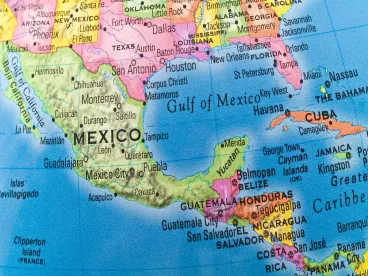On July 21, 2023, the Bureau of Ocean Energy Management (BOEM) issued a Final Sale Notice (FSN) for offshore wind leases covering three areas on the Outer Continental Shelf (OCS) of the Gulf of Mexico (GOM). The auction will include a 102,480-acre area off the coast of Lake Charles, Louisiana and two areas off the coast of Galveston, Texas totaling nearly 200,000 acres. On August 29th, up to fifteen qualified bidders will vie to become the first offshore wind leaseholders in this high-potential region.
The National Renewable Energy Lab (NREL) has reported that the broader Gulf holds about 15% of the gross offshore wind energy potential in the U.S. and 25% of the country’s technical offshore wind energy potential. According to BOEM, the three areas included in the auction have the potential to power almost 1.3 million homes based on an estimated of 12.8 gigawatt hours per year of production.
Interested parties can learn more about the upcoming auction, key takeaways from auctions finalized in New York, North Carolina and California in 2022, and unique local considerations that may impact GOM bidding below.
Key Developments in the GOM Auction to Date
On January 11, 2021, BOEM published a notice of intent to prepare an environmental assessment (EA) to consider potential environmental consequences of activities resulting from the lease sales. Following the notice of intent, BOEM solicited comments on the draft EA on July 20, 2022. The customary 30-day comment period, extended to 45 days upon bidder request, followed. During this time BOEM held two public meetings on August 9 and August 11.
In February of 2023, BOEM announced the Proposed Sale Notice (PSN) for the GOM. During the 60-day comment period, BOEM received comments on several lease stipulations that addressed BOEM’s ongoing commitment to engage with underserved communities and local stakeholders. The following were among the requested stipulations ultimately included in the Final Sale Notice (FSN):
providing credits to bidders who commit to supporting workforce training programs and developing a domestic supply chain for the offshore wind energy industry;
providing credits for establishing and contributing to new or existing fisheries compensatory mitigation funds; and
requiring that lessees provide regular progress reports summarizing engagement with stakeholders including Tribes and other ocean users potentially affected by proposed activities.
These stipulations build upon actions taken by BOEM in 2022 to encourage earlier, more frequent, and more comprehensive engagement with stakeholders. In the New York Bight auction for example, BOEM included lease stipulations that required support for the US offshore wind workforce and supply chain. In the subsequent Carolina Long Bay auction, BOEM built upon the approach taken in the Bight auction by implementing a bidding credit worth up to 20% for contributions to the development of the domestic offshore wind workforce or supply chain. BOEM took this approach one step further in the California auction by offering bid credits totaling 30%, including credits worth up to 10% for entry into community benefit agreements (CBAs) with stakeholders impacted by offshore wind development.
While BOEM adopted a California-style bid credit approach in the GOM with bid credits totaling up to 30%, there is a relatively significant variance in the GOM guidelines reflecting local concerns. In California, up to 10% worth of credits were available for generalized community benefit agreements; the GOM rules have narrowed the 10% credit to actions supporting a “Fisheries Compensatory Mitigation Fund,” which will address gear loss and damages resulting from all phases of the subject project, from development to decommissioning.
BOEM published the Final Environmental Assessment and Finding of No Significant Impact (FONSI) on May 26, 2023 and published the FSN on July 21. Between the date of publishing and the mock auction on August 28, qualified bidders who intend to proceed will complete bidder’s financial forms outlining strategies for billing credits and make bid deposits.
Key Takeaways from the 2022 Auctions
2022 was an impactful year for the U.S. offshore wind industry. According to a market report earlier this year by the Business Network for Offshore Wind, the U.S. offshore wind market saw $9.8 billion in new investments in 2022, more than triple the total in 2021. These investments included $5.4 billion from the three aforementioned BOEM auctions and over $4 billion directed to port infrastructure, supply chain development and transmission. The Business Network also reported that offshore wind-related contracts grew by 36 percent and that long-term state targets increased by 79 percent in 2022, led by California, Louisiana, New Jersey and Rhode Island. In addition, the year was marked by federal legislation in the Inflation Reduction Act (IRA) that could prove highly impactful.
However, the headlines in 2023 have been less positive. Multiple factors have led to increased negative perceptions this year, chief among them power purchase agreement pricing concerns, marine mammal concerns and the cumulative impacts of recent inflationary pressures.
While many factors will play into bid pricing, potential GOM bidders can find valuable insights from auctions finalized in 2022. Here are the key takeaways:
The price per acre decreased with each successive auction with the New York Bight standing out as an extreme outlier ($9,000/acre vs. Carolina Long Bay (CLB) at $2,800/acre and California at just over $2,000/acre). While capacity per lease area (1.2 GW per area in New York Bight, 0.9 GW per area in California, and 0.65 GW per area in CLB) possibly contributed to the differences in top-line numbers, a number of other factors could help explain the disparity in per-acre pricing. While not definitive by any means, BOEM’s Decision Memorandum for the GOM auction indicated the three areas up for bid could fetch between $150M and $500M. This would place pricing between $500/acre and $1,600/acre, continuing the downward trend that has been in play since early 2022.
Macro-economic and general market conditions such as rising interest rates, supply chain shortages, and inflation – still at play in 2023 – may have discouraged qualified bidders from participating in the California auction and influenced cautious behavior by those who did participate.
Technical factors, such as the greater cost to develop projects using floating turbines in the California lease areas, also likely impacted bidder behavior in the West Coast’s first auction. While some areas of the Gulf will potentially utilize floating turbines, these are not currently expected to play a role in the three areas selected for the upcoming auction.
Bid strategy and game theory also play a role once the bidding begins. In New York and Carolina Long Bay, there were more than twice as many bidders as available lease areas, while in California only seven entities (including one bidder who dropped out early) competed for five areas. If GOM bidding starts with multiple bidders for each of the three areas, it is likely that competitive pressure will lead to higher bid pricing, and vice versa.
Gulf-Specific Bidding Considerations
While previous auctions provide datapoints for bid teams, there are factors unique to the Gulf that could have a significant impact on the GOM bidding and eventual project development.
The Gulf’s Port and Supply Chain Infrastructure Should be Positive Factors
The development of port infrastructure needed to support offshore wind development is ramping up along the eastern seaboard, with multiple projects scheduled for completion in 2023. Although there are existing deep-water ports in the region that are suitable for offshore wind installation and support vessels, offshore wind projects also require heavy lift wharfs, component laydown yards, and other specialized facilities for the assembly and transportation of wind turbines. These upgrades are being funded by a combination of direct investments by wind developers, third-party financing, and grants from federal, state, and local governments, including the Department of Transportation’s Port Infrastructure Development Grants.
On the West Coast, port development, while still largely in the planning stages, is shaping up to present significant challenges compared to the East Coast. For example, although the former lumber port of Humboldt slated for redevelopment is close to the lease areas awarded by BOEM in the Humboldt Wind Energy Area (WEA), an equivalent deep-water port with adequate wharf capacity does not exist near the Morro Bay WEA. Here, developers will have to look further afield – potentially, as far south as Port Hueneme, which is the only deep-water port between San Francisco and Los Angeles.
Conversely, the Gulf of Mexico has a rich port infrastructure given its oil drilling history, and developers are less likely to face the same challenges as anticipated on the West Coast. NREL reports have sited multiple existing ports (Port Isabel, Port Arthur and Pensacola) as potentially advantageous port sites. Additionally, proximity to oil and gas supply chains are positive factors with respect to offshore wind development in the Gulf. While upgrades and retrofits will be required, bidders will not need to weigh such costs as heavily as they did in the nascency of the northeast market or more recently on the West Coast.
The Gulf also has decades of precedents for shipping lanes, fisheries impact mitigation and local engagement. The presence of hydrogen processing and shipping facilities in the area will give developers the opportunity to advance green hydrogen efforts. And, while the lack of locked-in power sales agreements may delay financing, it will help developers avoid the pricing issues at play currently in the northeast. Finally, while Texas has not yet set any state-level goals, in 2022 Louisiana set a 5 GW offshore wind installed capacity goal showing strong local support.
Potential Downside Factors
Like all lease areas to date, there are various potential downside factors in the Gulf as well. These include the proximity of major fisheries, Coast Guard facilities and North American Aerospace Defense Command activities in the area as well as potential third party use of sediments for commercial purposes. And, while the oil and gas industry’s existing supply chain and port infrastructure is a net benefit to offshore wind, it also points to existing uses that could potentially impact later-in-time projects in terms of resource allocation and legal access rights. The map of California, complete with existing naval and tribal uses, presented interesting project planning challenges to bidders; existing uses in the Gulf may be even more difficult to navigate.





 />i
/>i

